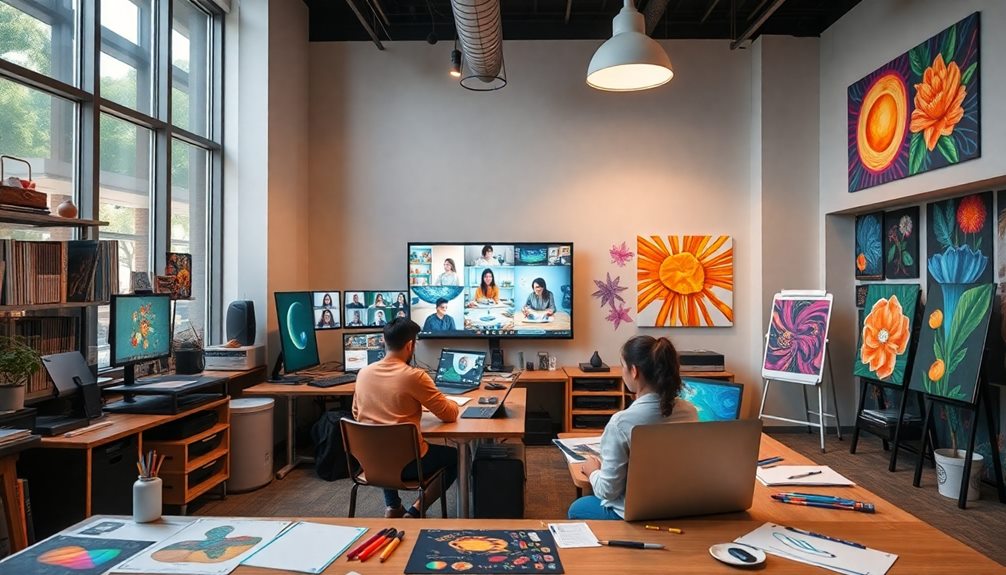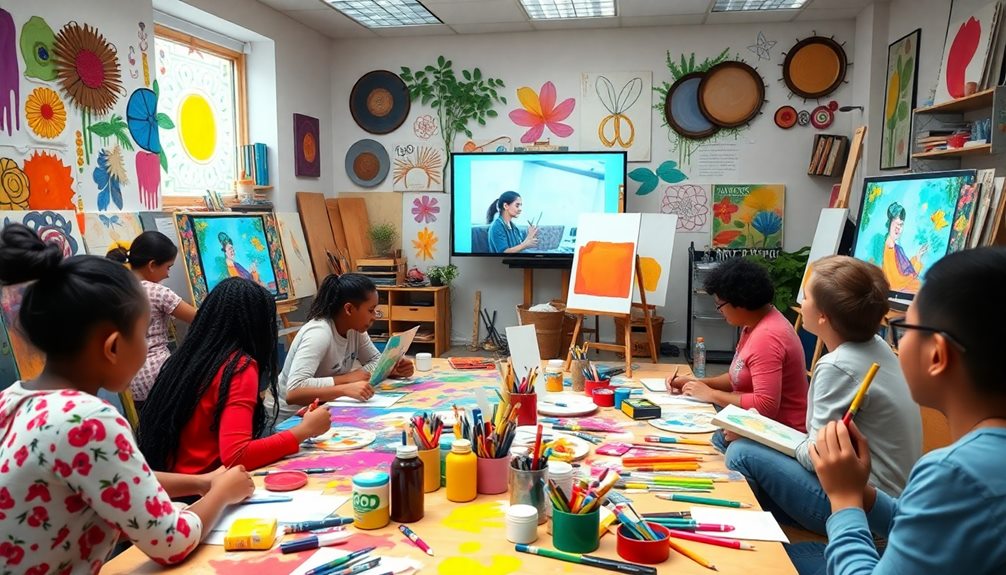Building an art education business starts with knowing your market. Identify who your students are and what they want to learn. Choose a location that's easy to access and inspires creativity. Develop a curriculum that includes diverse art disciplines and keeps up with trends. Hire qualified instructors who can engage students effectively. Implement a strong marketing strategy, utilizing social media and community events to attract interest. Finally, manage your finances carefully to guarantee sustainability. There's much more to uncover that can help you thrive in this creative venture.
Key Takeaways
- Conduct thorough market research to identify student preferences and define your target market by age and skill level.
- Choose a location with high visibility, accessibility, and a creative environment that complies with zoning regulations.
- Develop an engaging curriculum that includes various art disciplines and adapts based on student feedback and industry trends.
- Hire qualified instructors with strong backgrounds in Fine Arts and teaching experience, emphasizing ongoing professional development.
- Utilize effective marketing strategies, including email campaigns, social media engagement, and community involvement, to attract and retain students.
Understanding Your Market

Understanding your market is essential for the success of your art education business. Conducting thorough market research helps you identify the preferences and interests of potential students. This knowledge allows you to tailor your course offerings effectively to meet local demand.
By defining your target market, including age groups and skill levels, you can create focused marketing strategies that resonate with prospective students.
Competition analysis is another critical step. Analyzing local competitors helps you understand their unique selling points and reveals gaps in the market that your art education business can fill.
Engaging with community members through surveys and interviews provides valuable insights into desired art forms and educational formats. This information enables you to refine your offerings and enhance your appeal.
Understanding the local demand for various art disciplines—such as traditional painting, digital art, or sculpture—is essential. It guarantees your curriculum aligns with student interests and promotes sustainability.
Choosing the Right Location

When it comes to choosing the right location for your art education business, you've got to prioritize visibility and accessibility. High foot traffic areas, like those near schools, community centers, or art districts, can greatly boost your visibility and attract potential students.
You'll want a space that's not only easy to get to but also offers ample parking and access to public transportation for students and their families.
Your chosen location should be inspiring, fostering creativity with plenty of natural light and enough room for classrooms and studios. It's also important to have the ability to showcase student work, creating a vibrant atmosphere that draws people in.
Don't forget to research zoning laws in the area. Ensuring that the location permits educational activities is essential for compliance with local regulations.
Finally, evaluate the competition within the area. By positioning your business strategically, you can differentiate it from existing art education providers, giving you a competitive edge.
Making informed decisions about your location can set the foundation for your art education business's success.
Crafting an Engaging Curriculum

Location sets the stage for your art education business, but the heart of your operation lies in crafting an engaging curriculum. To keep your art classes dynamic, guarantee your curriculum covers various disciplines like drawing, painting, sculpture, and digital art. This diversity caters to the interests and skill levels of aspiring artists.
Additionally, fostering a supportive nature in your curriculum can create a more welcoming environment for students, similar to the characteristics of a real gem in relationships.
Regularly updating your curriculum to reflect current trends and techniques is vital for maintaining student engagement. Incorporate theoretical components, such as art history and critique, along with practical exercises. This balanced approach helps students develop a thorough understanding of artistic practices.
Foster continuous student engagement by providing opportunities for exhibitions, showcases, and collaborations with local artists and art professionals. These experiences not only enrich learning but also create a sense of community and belonging among your students.
Lastly, be responsive to feedback from students and industry professionals. Adapting your lesson plans based on their insights guarantees your curriculum remains relevant and meets the aspirations of your students.
Hiring Qualified Instructors

When you're hiring qualified instructors, focus on candidates with a solid educational background in fine arts or art education.
It's also essential to prioritize ongoing professional development opportunities, as this not only attracts top talent but enhances their teaching effectiveness.
Instructor Qualifications and Experience
Hiring qualified instructors is vital for the success of your art education business, as their expertise directly influences the quality of your programs. Start by prioritizing candidates with formal education in art, such as a Bachelor's or Master's degree in Fine Arts or Art Education. This guarantees they have a solid foundation in artistic techniques and effective pedagogical methods.
Next, look for instructors with at least three years of teaching experience, as this indicates their ability to manage diverse groups of students. Consider the importance of diverse artistic backgrounds; instructors skilled in various disciplines like painting, sculpture, and digital art will enrich your curriculum and attract a broader student demographic.
Lastly, confirm potential instructors demonstrate strong communication skills. These skills are vital for fostering a collaborative learning environment, enhancing student satisfaction and retention rates.
| Qualification | Importance |
|---|---|
| Formal Education | Solid foundation in artistic techniques |
| Teaching Experience | Proven ability to engage diverse students |
| Diverse Artistic Backgrounds | Enriches curriculum, appeals to broader audiences |
| Communication Skills | Fosters collaboration and support |
| Professional Development | Keeps instructors current with industry trends |
Ongoing Professional Development Opportunities
To maintain the high standards set by qualified instructors, your art education business should prioritize ongoing professional development opportunities. Providing workshops and certifications keeps your instructors updated on the latest techniques and trends, fostering a culture of continuous learning. This commitment enhances the quality of art education and directly impacts student outcomes.
Implementing mentorship programs is another effective strategy. Experienced instructors can guide newcomers, enhancing teaching quality and promoting collaboration, essential for innovative curriculum development.
Regular performance evaluations and feedback from both students and instructors help identify areas for improvement, ensuring that teaching methods stay effective and relevant.
Encouraging instructors to engage in community art projects not only keeps them connected to the art world but also enriches their teaching. Real-world applications of their skills inspire students and lend authenticity to their instruction.
Developing a Marketing Strategy

In crafting a successful marketing strategy for your art education business, it's essential to embrace a multi-faceted approach that resonates with your target audience. Start by implementing marketing strategies to attract potential students through online advertising and engaging social media platforms.
Since 54% of consumers prefer ads on social media, utilize these channels to reach and connect with your audience effectively. Additionally, consider incorporating elements of storytelling in your marketing efforts, as the power of short speeches can create emotional resonance and captivate your audience.
Don't underestimate the power of community engagement. By participating in local events and forming partnerships, you'll strengthen your presence, as 78% of consumers are more likely to support businesses that actively contribute to their community.
Create valuable content to build brand awareness. Offer free workshops or art challenges, driving word-of-mouth referrals, which influence up to 92% of purchasing decisions.
Moreover, leverage email marketing campaigns to keep potential students informed about upcoming classes and promotions. With an impressive ROI of $42 for every $1 spent, this strategy can greatly boost engagement.
Financial Planning and Management

Effective financial planning and management are essential for the success of your art education business. Start by developing a detailed budget that outlines all operational costs, including supplies, utilities, marketing materials, and instructor salaries. This careful planning guarantees financial sustainability and helps you set realistic financial projections.
Additionally, consider integrating strategies from creating a retirement savings plan to secure your personal financial future while managing your business finances. Explore various funding options, such as grants specifically for art education, to supplement your initial investments and ongoing operational costs.
Regularly monitor and reassess your class pricing based on market demand and expenses to maintain profitability, guaranteeing you don't alienate potential students.
Implement strong financial management practices by keeping detailed records of your income and expenses. This not only facilitates tax preparation but also allows for thorough financial analysis.
Additionally, consider setting aside a portion of your profits for reinvestment in materials, technology, or facility improvements. This strategy supports long-term growth and enhances the quality of education you provide.
Leveraging Technology in Education

Embracing technology in art education can transform the way you teach and how students learn. By leveraging technology, you can integrate digital platforms like virtual galleries and online portfolios, allowing students to showcase their work to a broader audience. Educational apps enhance learning experiences with interactive tools for art history, techniques, and project management, catering to various learning styles.
Here's a quick overview of how you can leverage technology in your art education business:
| Tool Type | Purpose | Benefits |
|---|---|---|
| Digital Platforms | Showcase student work | Wider audience reach |
| Educational Apps | Enhance learning experiences | Interactive, caters to learning styles |
| Collaboration Tools | Facilitate real-time feedback | Builds a creative community |
| Digital Art Tools | Expand medium exploration | Aligns with industry trends |
| AI Tools | Assist in lesson planning | Enables personalized learning |
Building Community Connections

Building strong community connections is crucial for the success of your art education business. Engaging with local art communities can enhance your visibility and attract potential students. Consider partnering with organizations or artists for collaborative projects that showcase your skills and teaching style.
Hosting free workshops or community events allows families to experience what you offer, which can encourage enrollment. Networking is essential, so join local business associations or art organizations. These connections can lead to mutual promotions and support within the community.
Actively participating in community service initiatives, like donating art classes or supplies, builds goodwill and strengthens your reputation as a community-focused entity.
Utilize social media platforms to share your community-related activities and highlight student projects. This not only creates an online presence that resonates with local audiences but also encourages word-of-mouth referrals.
Frequently Asked Questions
How to Start an Art Education Business?
To start an art education business, you'll need to analyze local demand, create a diverse curriculum, find a suitable location, develop a marketing strategy, and secure the necessary permits. It's all about planning and execution!
Is an Art Business Profitable?
An art business can be quite lucrative, especially with creative classes and enchanting community events. By blending passion with strategy, you can secure steady sales and savor success in this colorful industry.
Can You Make Money Teaching Art?
Yes, you can make money teaching art. Many art instructors earn a solid income through teaching positions, private lessons, online courses, and workshops. Selling your artwork also adds to your overall financial success in this field.
How to Build a Profitable Art Business?
Imagine planting a seed; nurture it with market research, a vibrant curriculum, and effective marketing. Water it with competitive pricing and technology, and watch your art business blossom into a profitable garden of creativity.
Conclusion
In building your art education business, remember that "a journey of a thousand miles begins with a single step." By understanding your market, choosing a prime location, and crafting a vibrant curriculum, you're setting the stage for success. Don't forget to hire skilled instructors and connect with your community. Embrace technology to enhance learning and guarantee financial stability. With passion and dedication, you're not just teaching art; you're inspiring creativity in others. Let's get started!








